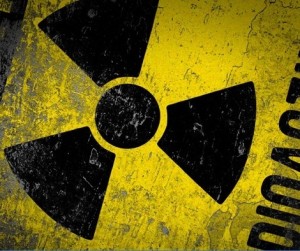 The survey meter went overscale, so no one knows how high the actual radiation really is.
The survey meter went overscale, so no one knows how high the actual radiation really is. TEPCO hasn't updated the "survey map (contamination map)" of the plant for about a month, and I've been wondering why. (They have a new one out now, but it doesn't mention the exhaust duct at all.)
If you are exposed to 10 sieverts radiation in a short time, you will be dead.
Photo is from Kyodo News Japanese, with the original photo by the Ministry of Defense. The exhaust duct is where the black arrow is pointing.
Not clear from the Jiji article below, but the Kyodo article does say the meter went overscale and the accurate measurement is not available.
From Jiji Tsushin (11:59PM JST 8/1/2011):
東京電力は1日、福島第1原発1、2号機の原子炉建屋の間にある屋外の排気筒の表面で、過去最高の1時間当たり10シーベルト(1万ミリシーベルト)以上の放射線量が測定されたと発表した。測定した作業員の被ばく量は最大4ミリシーベルトだった。
TEPCO announced on August 1 that the highest radiation of over 10 sieverts/hour (or 10,000 millisieverts/hour) was detected on the surface of the exhaust duct between Reactor 1 and Reactor 2 at Fukushima I Nuclear Power Plant. The workers who measured the radiation were exposed to maximum 4 millisieverts of radiation.
これまでの最高値は、1号機原子炉建屋内で6月に測定された同4000ミリシーベルト。同10シーベルトを仮に6分間防護服などなしに浴びると、1000ミリシーベルトを被ばくすることになり、吐き気やリンパ球の急激な減少などの症状が出る。
Prior to this reading, the highest radiation measured was 4,000 millisievert/hour [or 4 sieverts/hour] measured inside the reactor building of Reactor 1 in June. If one is exposed to 10 sieverts/hour radiation for 6 minutes without any protection, he would get 1,000 millisieverts [or 1 sievert] radiation, the level which causes nausea and rapid decrease of lymphocytes.
東電は半径数メートルを立ち入り禁止にするとともに、今後、付近に鉄板を設置するなどして放射線を遮蔽(しゃへい)する。ただ、この付近での作業は予定されておらず、今後の事故収束作業への影響はないという。
TEPCO will prohibit access to the area within a few meters radius of the duct, and plans to shield the radiation by installing steel panels around the area. However, according to TEPCO, there is no work planned near the area, and there will be no effect on the progress of the work at the plant.
東電によると、排気筒には非常用ガス処理系と呼ばれる配管が接続されており、この接続部で高線量が測定された。1号機では震災直後の3月12日、原子炉格 納容器の圧力逃がし弁を開く「ベント」が行われたが、その際に、容器内の空気がこの配管の中を通った。東電は、通過した気体に含まれる放射性物質が配管内 に付着し、何らかの理由で高い放射線量になったとみている。
According to TEPCO, the pipe for the emergency gas process system is connected to the exhaust duct, and it was at the joint that the high radiation was measured. On March 12 right after the earthquake/tsunami, they did the venting in Reactor 1, in which the pressure release valve on the Containment Vessel was opened to let the air inside the CV out. TEPCO thinks the radioactive materials in that air somehow got attached inside the duct, causing the high radiation.
Wait a minute. How could the work at the plant not be affected? TEPCO is going to put the gigantic cover over Reactor 1, and this exhaust pipe is right in the way.
(h/t Dr. Ono and anon readers)








No comments:
Post a Comment